Site menu:
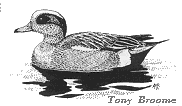
April 2013 Newsletter
Species Spotlight - Sanderling.
Appeal for Voluntary Wardens at Neston Reedbed.
March Bird News.
Forthcoming Events.
Latest Newsletter.
Species Spotlight - Sanderling
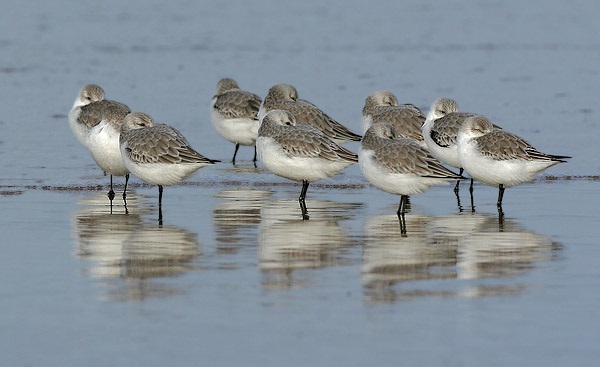
It is said that Sanderlings visit every
beach in the world
outside Antarctica at least once a year. I don't know whether that is
literally true but they are certainly widespread globally and always
a delight to see scurrying along the tide line.
They are easy enough to
identify even for beginners, although, as we don't see many summer
plumaged birds here on the Dee Estuary these have been known to fool
even experienced
birders!
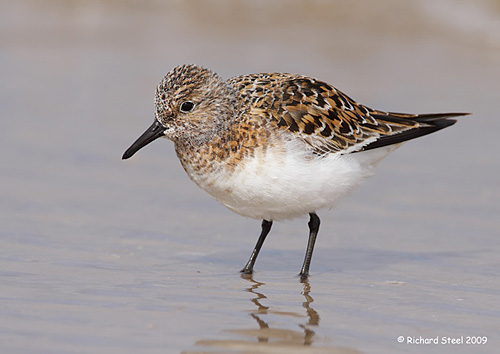
Unlike most of our waders they prefer sand to mud and are therefore found almost exclusively along North Wirral, West Kirby, Hilbre and between Point of Ayr and Gronant, I don't recall ever seeing any inside the estuary proper.
The
last two winters (2011/12 and
2012/13) have seen good numbers of over-wintering Sanderling
locally. The highest ever Wetland Bird Survey (WeBS) winter count was
on November 2012 with 2,158 and there have been four counts of 1,000 at
West Kirby and a max count at
Hoylake of 1,900. A good 2012 breeding season in east Greenland, due to
a good
Lemming year, may well have boosted numbers this last winter (Arctic
Foxes eating Lemmings rather than Sanderling
eggs/chicks!). WeBS
counts
for the Dee Estuary, carried out since 1970, do vary wildly from winter
to winter (e.g. max in 2000/01 was just 100 but a year later was 550),
but the long term trend for over-wintering birds shows a small but
steady increase with the five year mean currently at 860. In the 1970s
we used to get 7,000 or more during both spring and return passage, but
those migrating birds seem now to prefer the Alt Estuary/Formby
beach and the Ribble Estuary.
Nationally WeBS counts also show a slow
but
steady increase, and the East Atlantic population (Calidris alba alba)
as a whole is thought to be stable, perhaps increasing, and
stands at about 120,000 birds with around 27,000 wintering in
North-west
Europe, the rest flying south to Africa for the
winter. Any of these estimates should be treated with some caution,
however, as Sanderlings are notoriously difficult to survey accurately
as they are so widespread along open coasts often well away from
concentrations of other waders at estuarine sites. A recent review of
UK Sanderling numbers actually indicates quite a sharp decrease
despite the slow rise shown by WeBS, this may possibly be due to
previous over-estimations of birds on open beaches many of
which are not counted for WeBS.
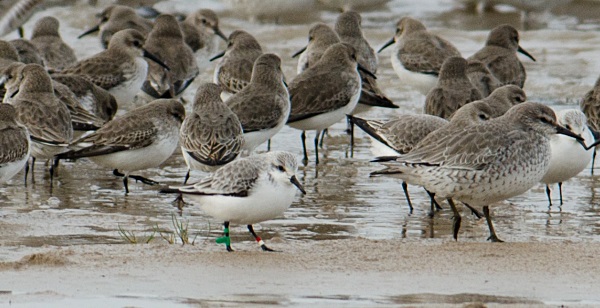
It was once thought that most of the European over-wintering birds bred in Siberia with the Greenland breeding birds moving further south on passage. Colour ringing over the past few years has changed that view and we now know that large numbers of Greenland breeding birds winter in NW Europe, including the Dee Estuary. In fact, we don't really know if Siberian breeding birds visit NW Europe in significant numbers at all, the evidence is very sparse and a colour ringing project is required to determine their exact migration routes and wintering grounds.
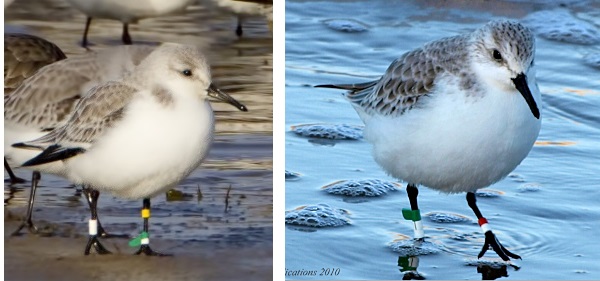
Left: Bird 1 (G5YWWW) at Hoylake on Jan 12th 2013 (Charles Farnell).
Right: Bird 2 (G4RWWW) at Leasowe on Jan 3rd 2010 (William Boyce).
One of the joys of colour ringing is that anybody can contribute to the research into migration routes and the distribution of the different populations. Locally a small group of us have been collecting Colour Ringed (CR) Black-tailed Godwit and Knot records over several years, but in 2013 we have concentrated our efforts on Sanderlings. Over the set of spring tides at Hoylake in January (see February and March Newsletters) a total of five CR Sanderlings were photographed with further sightings in February and March giving a total of nine birds. The table below gives a summary of these birds plus a map illustrating their movements.
| Bird No. | Date Ringed | Ringing Location | Dates
seen on North Wirral |
Location |
|---|---|---|---|---|
| 1 | 27/6/07 | Zackenberg, E Greenland | 14/11/09 18/11/12 12, 13/1/13 11, 14/3/13 |
New
Brighton Hoylake Shore Hoylake Shore Hoylake Shore |
| 2 | 14/5/09 | Sandgeroi, SW Iceland | 03/1/10 20/10/12 12, 13, 14/1/13 27/2/13 12, 13/3/13 |
Leasowe
Shore Hoylake Shore Hoylake Shore Hoylake Shore Hoylake Shore |
| 3 | 20/5/10 | Sandgeroi, SW Iceland | 27/2/13 | Hoylake Shore |
| 4 | 30/5/11 | Sandgeroi, SW Iceland | 12/3/13 | Hoylake Shore |
| 5 | 28/7/11 | Hochestetter Forland, E Greenland | 12,
13, 14/1/13 12, 14/3/12 |
Hoylake
Shore Hoylake Shore |
| 6 | 22/5/12 | Sandgeroi, SW Iceland | 17/11/12 12, 14/1/13 11, 12, 14/3/13 |
Hoylake Shore Hoylake Shore Hoylake Shore |
| 7 | 22/5/12 | Sandgeroi, SW Iceland | 12/1/13 | Hoylake Shore |
| 8 | 22/6/12 | Zackenberg, E Greenland | 13,
14/1/13 12, 14/3/13 |
Hoylake Shore Hoylake Shore |
| 9 | 16/8/12 | Griend, Wadden Sea, Netherlands |
12, 13/1/13 13, 14, 15/3/13 28/3/13 |
Hoylake Shore Hoylake Shore Hoylake Shore |
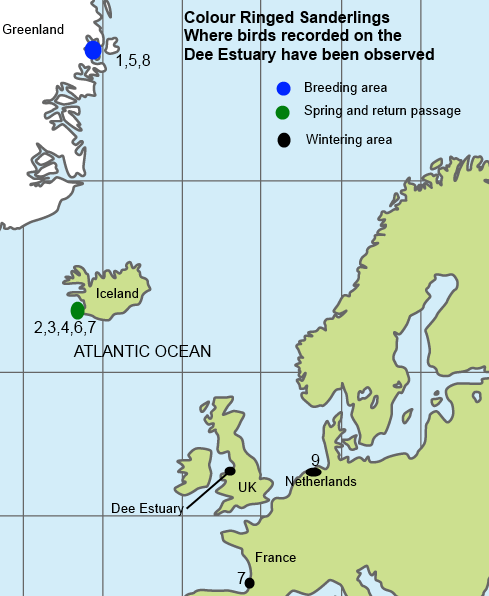
The numbers on the map refer
to the birds shown in the above table.
Map kindly provided by University of Texas Libraries (text
etc. added by the author).
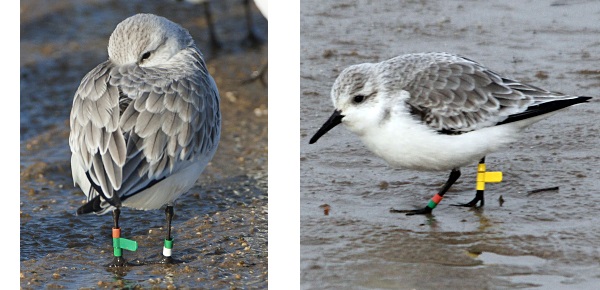
Left: Bird 8 (G5RGGW) at Hoylake on Jan 14th 2013 (Matt Thomas).
Right: Bird 9 (Y6RGYY) at Hoylake on Jan 13th 2013 (Colin Millington).
There are several interesting observations to add to these records:
1. The records confirm that Sanderlings are very site faithful, you can see bird 1 has been visiting North Wirral since at least 2009, likewise with bird 2 since 2010, the latter spending all last winter here.
2. The Sanderling Project Team tell me that Hoylake is the first location where three Sanderlings ringed in their breeding location of North-east Greenland have all been seen together in one flock (birds 1, 5 and 8).
3. Birds 1 and 8 were ringed as adults when incubating a clutch of four eggs (bird 1 in 2007, bird 8 in 2012) whereas bird 5 was ringed as a large chick.
4. If you want to see Sanderlings in Iceland you don't have to travel very far as the beaches at Sandgeroi are only a few miles west of Reykjavik International Airport! This is a major staging area in May for birds breeding in Greenland, and also post-breeding. Most of the birds above which were ringed at Sandgeroi, were subsequently seen many more times at the same location. Bird 2, for example, has been seen there every year since it was ringed in 2009.
5. Bird 7 was in France from July 18th to September 20th 2011, the southernmost report of 'our' birds, some Greenland breeding birds make it as far as southern Africa.
Richard Smith
A couple of interesting links:
Following
colour ringed migratory shorebirds around Europe, by Matt Thomas
and
A
movie clip of Sanderlings being caught and ringed in Mauritania,
the commentary is in Dutch but the video is self explanatory.
Sources of information for this article:
1. Jeroen Reneerkens 2013,
pers. comm., 7th March.
2. Jeroen Reneerkens et
al., Sanderlings using African-Eurasian flyways: a review
of current knowledge, Wader
Study Group Bull. 116(1):2-20, 2009.
3. International Wader Study Group Sanderling Project (Project Leader:
Jeroen Reneerkens) - see www.waderstudygroup.org/res/project/sanderling.php.
4. Juvenile Sanderling Newsletter 2012, IWSG Sanderling Project.
5. Simon Delany et al., An Atlas of Wader
Populations in Africa and Western Eurasia, Wetlands International,
2009.
6. Waterbirds in the UK (WeBS Report), reports from 1998/99 to 2010/11.
7. Neil Friswell and Colin Wells, Dee Estuary WeBS Annual Report,
2011/2012.
8. Musgrove et al.,
Overwinter population estimates of British Waterbirds, British Birds
(Vol. 104) July 2011 364-397.
9. Charles Farnell, John Jakeman, Colin Millington, Tanny Robinson,
Matt Thomas and Peter Welch who provided data and/or
photographs.
Lastly
- if you see any ringed Sanderlings please let me know - I can
report them for you (and forward you the feedback) or I can put you in
touch with the Sanderling Project Team directly. Any records will be
added to
the database and I'll let you know of any further sightings - many
thanks.
Voluntary Wardens Needed to Protect Neston Reed Bed
 Once
again the RSPB are organising voluntary wardening at Neston Reed Bed,
the scheme will begin near the end of March and run through until the
end of May. Wardening will take place each evening in order to protect
this important habitat from disturbance. I know in the past this scheme
has attracted birders who have realised what a good opportunity this
location is for some serious birdwatching with the possibility of
seeing migrating Ospreys and Marsh Harriers, large numbers of Little
Egrets flying in to roost, Bearded Tits, Hen Harriers, Short-eared Owls
and the numerous birds which breed in the reed bed. If you are
interested please contact Geoff Robinson (Geoffrey.Robinson@rspb.org.uk),
telephone 0151 353 8478.
Once
again the RSPB are organising voluntary wardening at Neston Reed Bed,
the scheme will begin near the end of March and run through until the
end of May. Wardening will take place each evening in order to protect
this important habitat from disturbance. I know in the past this scheme
has attracted birders who have realised what a good opportunity this
location is for some serious birdwatching with the possibility of
seeing migrating Ospreys and Marsh Harriers, large numbers of Little
Egrets flying in to roost, Bearded Tits, Hen Harriers, Short-eared Owls
and the numerous birds which breed in the reed bed. If you are
interested please contact Geoff Robinson (Geoffrey.Robinson@rspb.org.uk),
telephone 0151 353 8478.
March Bird News
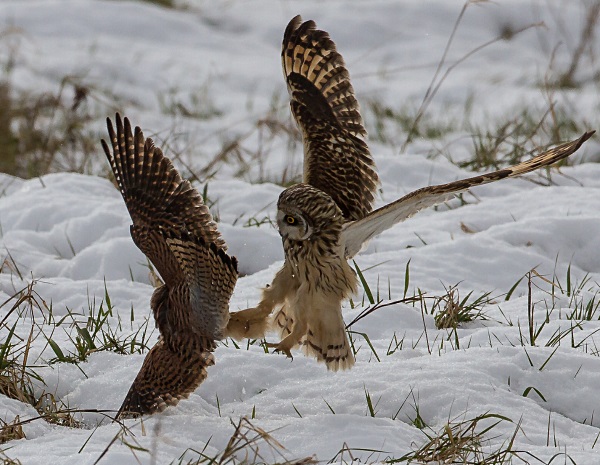
The table below shows the first arrival dates of some of our commoner spring migrants, as you see that cold east wind and blocking high pressure made everything late. We still await our first Swallow and Willow Warbler and the first Wheatear has yet to arrive on Hilbre.
| Species | 2013 | Location (2013) | 2012 | 2011 |
|---|---|---|---|---|
| White Wagtail | 14th March | Leasowe Lighthouse | 8th March | 11th March |
| Wheatear | 17th March | Leasowe Lighthouse | 9th March | 13th March |
| Sand Martin | 28th March | West Kirby | 28th Feb | 12th March |
| Swallow | 17th March | 20th March | ||
| Willow Warbler | 20th March | 16th March | ||
| Whitethroat | 1st April | 8th April | ||
| House Martin | 4th April | 25th March | ||
| Cuckoo | 14th April | 20th April | ||
| Swift | |
26th April | 17th April |

The cold east wind meant that there were good numbers of waders all month including 4,000 Grey Plovers counted by the RSPB Dee Estuary Manager (no less!) at Hoylake on the 2nd - one of the highest ever counts of this species here. This was during another great High Tide Birdwatch Event at Hoylake, the birds were further away than in January but we still had great views of at least 30,000 waders. Other max counts were 28,000 Knot and 8,700 Dunlin at Hoylake on the 1st, 750 Sanderlings at Leasowe and 22 Purple Sandpipers at New Brighton on the 2nd; even by the end of the month we still had 18,000 waders at Hoylake. Avocet numbers had reached 11 at Burton Mere Wetlands by the end of the month.
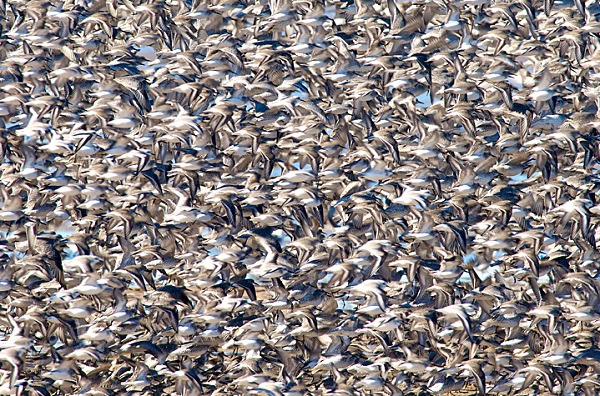
Up to three Hen Harriers, including two males, and six Short-eared Owls have been on the marshes, the ones at Parkgate giving great views flying close to the Prom. The first Osprey flew over Burton Marsh on the 28th with one over Red Rocks two days later. A Marsh Harrier flew over Little Eye on the 29th. A Rough-legged Buzzard flew over Heswall Shore and the Harp Inn at Little Neston on the 24th and a Red kite flew over the Connah's Quay Reserve on the 29th.
There were 15 records of Waxwings with a flock around West Kirby early in the month, max 46 on the 7th, and a flock of up to 30 at Neston towards the end of the month.
Pink-footed Geese numbers continue to increase, we've already had two counts of over 3,000 this winter but 5,000 on Burton Marsh on the 17th is almost certainly the highest ever recorded on the estuary (see the Geese on the Dee Estuary article). Rarer wildfowl included a Lesser Scaup on the 3rd and Green-winged Teal on the 15th, both at Burton Mere Wetlands, and a drake American Wigeon off Denhall Quay at the end of the month.

Three Mediterranean Gulls were off Leasowe on the 8th and an Iceland Gull flew past Red Rocks on the 13th. Single Black Redstarts were at Red Rocks on the 26th and another for several days by the Harp Inn, Little Neston. A large flock of Twites were in the Flint and Connah's Quay area, max 60 on the 16th.
Richard Smith.
What to expect in April
There will be plenty of movement out to sea and we should have hundreds of Gannets and also good numbers of Common Scoters, auks and Little Gulls as well as terns.
Hen Harriers and Short-eared Owls will still be on the marshes with Marsh Harriers passing through on their way north, look out also for Ospreys which usually fly fairly high up overhead.
Waders will also be on the move and many will be coming through from their wintering grounds much further south, including Whimbrels.
There will still be Waxwings passing through, although they are unlikely to hang around as they make their way back to Scandanavia.

Forthcoming Events
April Highest Spring Tides (Liverpool)
Also
see Tides
page.
26th April, 12.09hrs (BST), 9.6m.
27th April, 12.53hrs (BST), 9.7m.
28th April, 13.38hrs (BST), 9.6m.
Forthcoming Events
Organised by the Wirral
Ranger Service , Flintshire Countryside Service and/or the
RSPB:
All these events and walks have bird interest, even those not
advertised specifically for birdwatching. No need to book for these
events unless specified - please check below.
Also see 2013 Events Diary.
10am - 3pm (drop-in sessions).
Price: Members £3 (per child); non-members £6 (per child + 1 adult admission).
Drop in between 10am and 3pm to meet our team of expert wildlife photographers and learn the skills and techniques required to take you to the next level of wildlife photography. With photography stations set up across the reserve, you will have the chance to try your hand at photographing a wide range of wild subjects whilst being guided by an experienced photographer.
You will learn all about field craft techniques, camera settings, understanding your subject’s behaviour and much, much more. We will be running a photo competition for the best images captured on the day.
Suitable for children aged 7 to 15 years old, all skill levels and camera types (compact or DSLR).
All children must be accompanied by an adult.
Please ring 0151 353 8478 for further info.
Sunday 7th April, 10:30am - 12:30pm, Spring Happenings at Royden Park.
Discover what is happening during Spring at Royden Park.
What are those early flowers and listen to the bird songs as many prepare to nest.
This Ranger led walk discovers these and other interesting facts.
Sorry no dogs.
Meet at the Court Yard/Coach House Royden Park.
The Tea Servery is also open for refreshments.
Ring 0151 677 7594 for further info.
Saturday 27th April, Terns & Migrants at Point of Ayr.
9.30am start, high tide at 12.53pm so worth bringing lunch!
Price Free but Booking essential, please ring 0151 353 8478.
Point of Ayr is a fantastic mosaic of habitats on the outer edge of the famous Dee Estuary and is a vital feeding ground for thousands of terns and other migrant birds after their long journey from Africa. Join the experts from the RSPB for a free guided walk showcasing the wildlife of the area.
Directions: Meet in the Smugglers Inn Car Park, Station Road, Talacre
Thursday May 2nd, 9:00am - 2:00pm, Hilbre in the Spring.
Join the Coastal rangers on a guided walk across the sands to Hilbre Island.
Here we will look for some of the wildlife that Hilbre is famous for and learn about the fascinating history of this tidal island.
Watreproofs and good walking boots are rcommended.
Bring sunblock and some binoculars.
Booking essential, please ring 0151 648 4371.
Saturday 4th May, Birdsong & Breakfast at RSPB Burton Mere Wetlands.
7.00am - 9.00am
Price: RSPB members £3; non-members £5
Booking essential, please ring 0151 353 8478.
Get down to Burton Mere Wetlands for this one-off event as part of Wirral Walking Festival.
With a wonderful mixture of woodland and wetlands is there a better place to experience the early morning birdsong?
This is a fantastic opportunity to see the reserve 'out of hours' and you'll never know what other wildlife we might bump into... stick around afterwards for a light breakfast, hot drink and the chance to explore the rest of the reserve!
Saturday 4th May, Bluebells and Birdsong at RSPB Burton Mere Wetlands.
10:00am start.
Price: RSPB members £3; non-members £5.
Booking essential, please ring 0151 353 8478.
Come along to admire one of the best bluebell woodlands in the area. This two hour guided walk through Gorse Covert, 3.4 hectares of semi-natural ancient woodland, will allow you to enjoy the flowers whilst seeing and hearing the vast array of woodland birds we have nesting here.
Stick around afterwards to enjoy the rest of the wetland reserve, and a hot drink and sweet treat in the reception hide.
Sturdy footwear is essential.
Sunday 5th May, 4:30am - 6:30am, Dawn Chorus - Royden Park.
Join the Ranger at Royden Park and listen to the fantastic sounds of nature as birds sing at this very early time of year.
Meet at Court Yard/Coach House at Royden Park.
Sorry no dogs.
Please wear warm and waterproof clothing.
Booking essential. Ring 0151 677 7594.
Sunday 5th May, Dawn Chorus at RSPB Burton Mere Wetlands.
5.00am start.
Price: RSPB members £3; non-members £5.
Booking essential, please ring 0151 353 8478.
Get down to Burton Mere Wetlands and help us celebrate International Dawn Chorus Day.
With a wonderful mixture of woodland and wetlands is there a better place to experience the dawn chorus?
This is a fantastic opportunity to see the reserve 'out of hours' and you'll never know what other wildlife we might bump into... stick around afterwards for a chat, hot drink and the chance to have the reserve to yourself for another two hours!
Friday 10th May, 10:00am, The Birds of Wirral Country Park (Thurstaston).
Join staff and volunteers from the RSPB and Coastal Rangers to discover some of the birds that can be found in the freshwater, hedgerow, woodland, grassland and estuarine habitats within and adjacent to Wirral Country Park.
This walk includes stepped access to the Dungeons.
Please bring binoculars if you have them.
Booking essential, please ring 0151 648 4371.